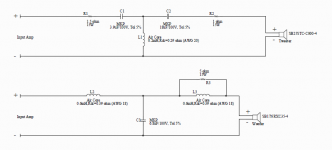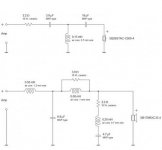Hi guys,
I'm going to be making a pair of bookshelf speakers using SB Acoustics SB17CRC35-4 and below is a link below of the frequency response chart,
as bad as this sounds I'm "stuck" using a 2khz 2nd order linktzwitz riley crossover which correct me if I'm wrong is 12db/octave slope. Now as seen on this graph, at just above 4khz you can see the massive breakup starting to occur, now playing "connect the dots" on the graph, if I use this 2khz 2nd order crossover at around 60db it just knicks that breakup, almost like I would cheekily get away with it just without not having any dramatic issues.
Whats your thoughts guys? I'm all ears. Cheers!

I'm going to be making a pair of bookshelf speakers using SB Acoustics SB17CRC35-4 and below is a link below of the frequency response chart,
as bad as this sounds I'm "stuck" using a 2khz 2nd order linktzwitz riley crossover which correct me if I'm wrong is 12db/octave slope. Now as seen on this graph, at just above 4khz you can see the massive breakup starting to occur, now playing "connect the dots" on the graph, if I use this 2khz 2nd order crossover at around 60db it just knicks that breakup, almost like I would cheekily get away with it just without not having any dramatic issues.
Whats your thoughts guys? I'm all ears. Cheers!

Last edited:
I read that about 10 times and I still have no idea what you mean.if I use this 2khz 2nd order crossover at around 60db it just knicks that breakup, almost like I would cheekily get away with it just without not having any dramatic issues.
If you implement 2kHz LR2 electrical then the filter will be:
-6dB @ 2kHz
-12dB @ 4kHz
-24dB @ 8kHz
Once you apply this to the measured frequency response you will find that at 3kHz it will be about -15dB (relative to 1kHz) but by 4.8kHz it is almost back up to -5dB again.
To hit an LR2 acoustical slope at the very least you will need a notch filter at 4.8kHz and probably another at 6.5kHz.
It will be much easier to try to hit LR4 acoustical. Put a deep notch at 5-5.5kHz and above 6kHz it will be far enough down that you no longer care if it tracks perfectly or not. Lowpass filter will probably need to be 3rd order as the deep notch gets you to 4th.
Last edited:
I read that about 10 times and I still have no idea what you mean.
If you implement 2kHz LR2 electrical then the filter will be:
-6dB @ 2kHz
-12dB @ 4kHz
-24dB @ 8kHz
Once you apply this to the measured frequency response you will find that at 3kHz it will be about -15dB (relative to 1kHz) but by 4.8kHz it is almost back up to -5dB again.
To hit an LR2 acoustical slope at the very least you will need a notch filter at 4.8kHz and probably another at 6.5kHz.
It will be much easier to try to hit LR4 acoustical. Put a deep notch at 5-5.5kHz and above 6kHz it will be far enough down that you no longer care if it tracks perfectly or not. Lowpass filter will probably need to be 3rd order as the deep notch gets you to 4th.
Sorry posted this late at night 😁 awesome advice , I will use a notch filter to remove that spike as -5db is still too much. What should be a target ? Make those spikes atleast -10db to not be an issue? Cheers
I hope you forgot a "k" or every one would buy that tweeter?
So as far as my cost lets me im using a parallel notch filter from 4.5-6khz (yes i know its narrow but I have 40UF caps lying around) with an attenuation on 9db
Which means a 40uf cap,
1 mH inductor
2.65 ohm resistor
am I on track here? Ive never used notch filters before... cheers!
Which means a 40uf cap,
1 mH inductor
2.65 ohm resistor
am I on track here? Ive never used notch filters before... cheers!
Hi guys,
I'm going to be making a pair of bookshelf speakers using SB Acoustics SB17CRC35-4 and below is a link below of the frequency response chart,
as bad as this sounds I'm "stuck" using a 2khz 2nd order linktzwitz riley crossover which correct me if I'm wrong is 12db/octave slope. Now as seen on this graph, at just above 4khz you can see the massive breakup starting to occur, now playing "connect the dots" on the graph, if I use this 2khz 2nd order crossover at around 60db it just knicks that breakup, almost like I would cheekily get away with it just without not having any dramatic issues.
Whats your thoughts guys? I'm all ears. Cheers!

I "think" I know what you are asking--- and the answer is: YES. If it were me, I wouldn't even consider using this driver. But, if you MUST, my suggestion is to use a wide-band notch filter to remove that junk. If left alone, the rise of the junk will only be down a few db's, even with 12 db/octave, and will be clearly audible as "not sounding so good".
I highly recommend you read the posts in this sticky article at the beginning of the multi-way forum:
Introduction to designing crossovers without measurement
It will teach you a lot about choosing crossover points, and even more importantly. how to use other people's measurements in software to simulate your own crossover.
With software simulation, you are not stuck to any particular topology. I use an ancient piece of Windows software called Speaker Workshop. But it can pretty much simulate any crossover topology and also has a crossover optimiser (with some limitations) built in.
Learning to use software to simulate a crossover will be the fastest way to speakers you are happy to listen to. Otherwise, you're really looking at a lot of trial and error, expensive re-ordering of crossover parts and more chance of giving up in frustration.
If you are doing this as a one of DIY (and have already bought the SB17's) - then lookup someone elses proven design and build that.
Introduction to designing crossovers without measurement
It will teach you a lot about choosing crossover points, and even more importantly. how to use other people's measurements in software to simulate your own crossover.
With software simulation, you are not stuck to any particular topology. I use an ancient piece of Windows software called Speaker Workshop. But it can pretty much simulate any crossover topology and also has a crossover optimiser (with some limitations) built in.
Learning to use software to simulate a crossover will be the fastest way to speakers you are happy to listen to. Otherwise, you're really looking at a lot of trial and error, expensive re-ordering of crossover parts and more chance of giving up in frustration.
If you are doing this as a one of DIY (and have already bought the SB17's) - then lookup someone elses proven design and build that.
Gents im scrapping the whole carbon cone and getting my hands on the Aluminum cones. Heres the frequency response for it.
Much more healthy and suitable for a 2ish khz crossover but ive decided to go 2nd order LWR @1.8khz, yes I know a 4th is more suitable but im trying to die down abit of cost.
An externally hosted image should be here but it was not working when we last tested it.
Much more healthy and suitable for a 2ish khz crossover but ive decided to go 2nd order LWR @1.8khz, yes I know a 4th is more suitable but im trying to die down abit of cost.
TBH, with all this dithering between 6" drivers, and some wildly inaccurate notch values like 0.1mH and 40uF, and vague talk of LR2, BW3 and LR4, I think you are winging it here a great deal! 
Usual diyaudio train wreck of dubious drivers and just the crossover to sort out. Well, how are you on crossovers and modelling? Pretty green, I reckon.
I am not giving you a hard time, but have you looked at the sort of speakers you might end up with here?
SBAcoustics-61-NAC
SBAcoustics-61-NRXC
SBAcoustics-61-MFC
I would take on the MFC polycone in 8 ohms, which is a simple notch on 2nd order and 2.5kHz XO, but which would also work 4th order @ 2.1kHz XO like the other two. I could make a very good guess at the crossovers without even tailoring it particularly to SB drivers.
6" SB17MFC35-8 :: SB Acoustics
The SB26ADC metal dome is well liked:
SB26ADC-C000-4 :: SB Acoustics
The time alignment option isn't critical, IMO. I do prefer higher order filters on tweeters, and higher crossover. Just sounds cleaner.
Below a typical couple of SB kits. The old flat baffle Eka and the newer notched one. Just to give you some ideas. They can't be bad.
Usual diyaudio train wreck of dubious drivers and just the crossover to sort out. Well, how are you on crossovers and modelling? Pretty green, I reckon.
I am not giving you a hard time, but have you looked at the sort of speakers you might end up with here?
SBAcoustics-61-NAC
SBAcoustics-61-NRXC
SBAcoustics-61-MFC
I would take on the MFC polycone in 8 ohms, which is a simple notch on 2nd order and 2.5kHz XO, but which would also work 4th order @ 2.1kHz XO like the other two. I could make a very good guess at the crossovers without even tailoring it particularly to SB drivers.
6" SB17MFC35-8 :: SB Acoustics
The SB26ADC metal dome is well liked:
SB26ADC-C000-4 :: SB Acoustics
The time alignment option isn't critical, IMO. I do prefer higher order filters on tweeters, and higher crossover. Just sounds cleaner.
Below a typical couple of SB kits. The old flat baffle Eka and the newer notched one. Just to give you some ideas. They can't be bad.
Attachments
Since Q asked earlier, the general ROT for reducing breakup is to make it at least -25dB from reference or nominal output. It is better to make this -40dB so it's basically inconsequential, or even -50dB where there is no semblance of hearing it in the audible passband.
Later,
Wolf
Later,
Wolf
- Status
- This old topic is closed. If you want to reopen this topic, contact a moderator using the "Report Post" button.
- Home
- Loudspeakers
- Multi-Way
- Assistance asked for crossover point?

